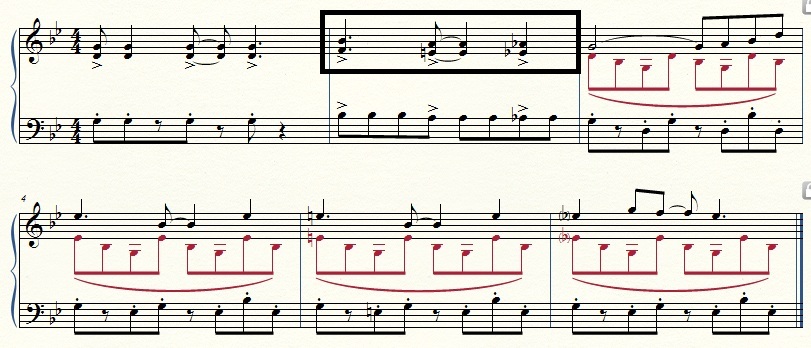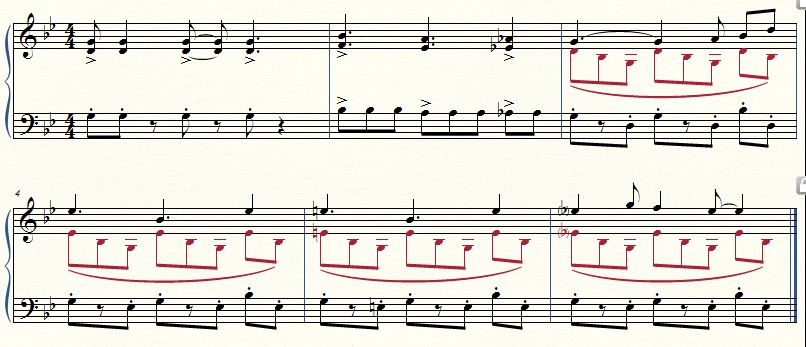|
Playing Skyward Sword has me in a Zelda mood, so let's take a look at a very popular tune from Zelda II: Adventure of Link! I haven't played the game myself and I'm told that it was not the best game in the Zelda franchise, but the Palace Theme is a favorite tune of many gamers I've met. A lot of video game music in the 80's and early 90's depended on strong melodies to make up for the limited hardware of its time. So, it makes sense that some of the most memorable game themes of all time are from that era. The melodies had to be super catchy, but what is it about melodies that makes them super catchy? What's the “hook” in the Palace Theme that keeps us listening? Let's get a little technical for a second: the definition of “melody” is a succession of musical tones which is perceived as a single entity. A melody, in its most basic form, is made up of two things: pitch and rhythm. So let's look at the first part of the Palace Theme's melody, just the pitches for a moment. Not the craziest melody in the world, right? I'm not saying that it isn't a “good” melody, I personally definitely enjoy it (and it's all up to your personal taste anyway)--but I notice that the melody-line isn't what I'd necessarily call very "active." For a point of reference, let's compare it to a melody like the original Legend of Zelda Overworld. Compared to the Palace Theme, it seems to me like there's a LOT more going on in the Overworld theme, right? The melody has a larger contour (shape), the harmonies and chords supporting it are varied and colorful, the rhythmic pattern with alternating triplets and dotted eighth-sixteenths grabs your attention. Ah-hah, the rhythm! That's just as important to the melody as the pitches—so let's look at the Palace Theme's rhythm for a moment. Right away, in the second bar, we see the rhythmic pattern that will drive the entire piece: dotted quarter, dotted quarter (represented by an eighth tied to a quarter), then quarter. The middle voice has an even stronger role in reflecting this rhythmic pattern—the arpeggios reflect the 3-3-2 pattern as well. If I were to change the beaming of this entire passage to reflect the rhythmic pattern, it would look like this. This is called additive rhythm: when a rhythmic pattern features irregular groups of durations. In common 4/4 time, normally we would just divide each beat into smaller groups; the whole note is divided into 2 halves, the 2 halves are divided into 4 quarters, the 4 quarter notes into 4 groups of eighth notes, etc. This is called divisive rhythm. But in this piece, the rhythm strongly reflects beat durations of 3 eighths, 3 eighths and then 2 eighths—we're adding the smaller beats up to make the bigger groups.
You see additive rhythm most often in asymmetrical meters like 5/8, 7/8—any meter that doesn't divide the beats equally. But as we see in the Palace Theme, additive rhythm can be applied to any type of meter, including the symmetrics. Contemporary composers sometimes notate additive rhythms in the time signatures themselves; in this case, it would be 3+3+2/8. So why didn't I notate it as such in my sheet music? Because there are sections of the piece that do not use additive rhythm. The B section starting at m. 27 is a fluid triplet feel on top of the sweeping 16th arpeggios, which is a really awesome part of the piece as well—by setting up such a strong additive pattern for A section, the B section's more straightforward, divisive rhythmic pattern becomes more noticeable and is a welcome break. Not only that, but the contour of the melody suddenly blows up, it starts a climbing scalar pattern; the rhythm has clearly become secondary to the pitches of the melody. Pretty cool right? In the first half of the piece, the rhythm is the driving force; in the second half, the pitches are the driving force. In this short piece, the composer has highlighted and featured each part of what makes up a strong melody: pitch and rhythm. Bam! Two points for Nakatsuka-san! Enjoy this week's transcriptions of the Main Titles, Overworld and Palace themes from Zelda II: The Adventure of Link. More on the way!
28 Comments
|
AuthorVideo game music was what got me composing as a kid, and I learned the basics of composition from transcribing my favorite VGM pieces. These are my thoughts and discoveries about various game compositions as I transcribe and study them. Feel free to comment with your own thoughts/ideas as well! Archives
July 2017
Categories
All
|





 RSS Feed
RSS Feed
